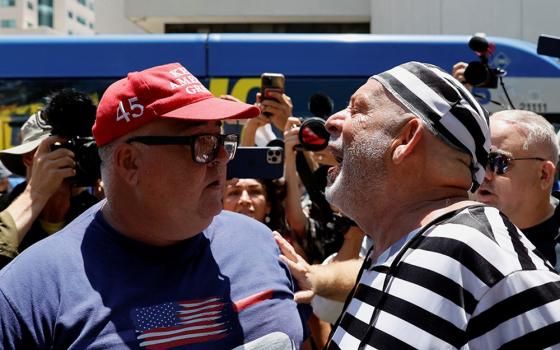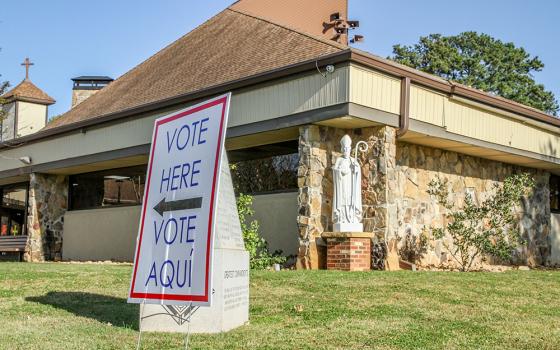By JOHN L. ALLEN JR.
New York
As the annual glut of year-end analysis and “Top Ten/Bottom Ten” lists draws to a close, here’s one striking fact about 2007 that so far no one seems to have highlighted: In this entire 12-month period, Pope Benedict XVI finished on the front page of the New York Times exactly twice.
The first piece came on January 8, about the resignation of his nominee as Archbishop of Warsaw amid charges of collaboration with the Communist-era secret police; the second on May 7, in a look ahead to his trip to Brazil. Otherwise, all the other major papal stories of the year, from the Latin Mass and “one true church” documents, to the Austria trip and the encyclical on hope, finished well inside.
To grasp the significance of this result, consider that 2007 was essentially Benedict’s third year as pope. By way of comparison, John Paul II in his third year finished on the front page of the Times a robust 25 times. Even setting aside the 13 pieces devoted to the May 13, 1981, assassination attempt, John Paul still outpaced Benedict as a newsmaker at a comparable point roughly six-to-one.
One could explain the contrast in terms of personality – John Paul the rock star, Benedict the professor – but I suspect the more decisive factor was Benedict’s “back to basics” message in 2007. His core focus was Christ, especially the indispensability of Christ for efforts to build a more humane world. That was the scarlet thread running through his speeches in Brazil, it was the heart of his book Jesus of Nazareth, and it surfaced repeatedly in his other writings and addresses.
Frankly, a pope preaching Christ simply comes off as “dog bites man” stuff to most news editors.
Yet beneath this veneer of familiarity, there was something original about the way Benedict presented the Christian basics in 2007, so much so that I would nominate it as perhaps the year’s most important neglected papal story. To put the story in a sound-bite, I would call it the emergence of “Affirmative Orthodoxy” as an interpretive key to Benedict’s papacy.
By “affirmative orthodoxy,” I mean a tenacious defense of the core elements of classic Catholic doctrine, but presented in a relentlessly positive key. Benedict appears convinced that the gap between the faith and contemporary secular culture, which Paul VI called “the drama of our time,” has its roots in Europe dating from the Reformation, the Wars of Religion, and the Enlightenment, with a resulting tendency to see Christianity as a largely negative system of prohibitions and controls. In effect, Benedict's project is to reintroduce Christianity from the ground up, in terms of what it’s for rather than what it’s against.
This spirit of “affirmative orthodoxy” was clear in Benedict’s first encyclical letter, Deus Caritas Est, in which the pope laid out a philosophical and spiritual basis for the church’s teaching on human love. His encouragement for the International Theological Commission to set aside the hypothesis of limbo offers another example. Without softening the traditional teaching that Christ’s grace, normally mediated through baptism, remains essential for salvation, Benedict nevertheless put the accent on hope.
Two more recent examples make the point.
In his recent encyclical, Spe Salvi, Benedict once again takes a classic Christian doctrine usually seen as foreboding and gives it a positive spin. In this case the doctrine is the Last Judgment, often presented over centuries of Christian theology, preaching and art as an implied threat – obey God’s law or face eternal damnation. Instead, Benedict presents the Last Judgment as an expression of hope – specifically, hope that justice will ultimately triumph in a world in which evil and corruption too often seem to have the upper hand.
“Faith in the Last Judgment is first and foremost hope — the need for which was made abundantly clear in the upheavals of recent centuries,” Benedict wrotes.
“I am convinced that the question of justice constitutes the essential argument, or in any case the strongest argument, in favor of faith in eternal life,” the pope said. “Only in connection with the impossibility that the injustice of history should be the final word does the necessity for Christ's return and for new life become fully convincing.”
Benedict provided another illustration of affirmative orthodoxy in his annual address to the Roman Curia on Dec. 21. This time the subject was evangelization, or the missionary drive to make converts to Catholicism.
In keeping with the thrust of a recent doctrinal note from the Congregation for the Doctrine of the Faith, Benedict insisted that the church cannot renounce the missionary imperative. Yet he argued that the motive for doing so is not that people will otherwise be damned, but rather that only through evangelization can the Kingdom of God announced by Jesus, with its promise of reconciliation and true happiness, reach its maximum potential in history.
“St. Paul actually felt himself under a sort of ‘obligation’ to announce the Gospel, not so much out of concern for the salvation of individual non-baptized people who have not yet heard the Gospel, but rather because he was aware that history in its totality could not reach its fulfillment until all people were reached by the Gospel,” Benedict said.
“It’s so important that forces of reconciliation, peace, justice and love reach humanity today,” the pope said. “It’s so important that these forces be aroused and reinforced, in the balance of human experience, over against the feelings and realities of violence and injustice that threaten them.”
“Through the encounter with Jesus and his saints, through the encounter with God, the balance of humanity is strengthened by those forces of good without which all our projects in the social order never become reality, but, facing the extraordinary pressure of other interests contrary to peace and justice, remain solely abstract theories,” Benedict said.
The traditional argument for missionary work has been the precariousness of individual salvation without baptism and the sacraments – in other words, a largely negative concern that souls may be lost. Benedict’s point of departure is different. The motive for mission, he suggests, is rather the positive conviction that the great human dreams of justice and peace must have Christ as their foundation, or else they will remain hollow promises.
To put the point differently, Benedict subtly shifted from an individualistic argument for evangelization to the collective welfare of humanity.
Benedict XVI himself provided the logic for “affirmative orthodoxy” in a 2006 interview with German journalists ahead of his trip to Bavaria. Here’s the relevant part of the exchange, as it was recorded by the German radio outlet Deutsche Welle:
Question: A month ago you were in Valencia for the World Meeting of Families. Anyone who was listening carefully, as we tried to do at Vatican Radio, noticed how you never mentioned the words "homosexual marriage," you never spoke about abortion, or about contraception. Careful observers thought that was very interesting. Clearly your idea is to go around the world preaching the faith rather than as an “apostle of morality.” What are your comments?
Obviously, yes. Actually I should say I had only two opportunities to speak for 20 minutes. And when you have so little time you can't say everything you want to say about “no.” Firstly you have to know what we really want, right? Christianity, Catholicism, isn’t a collection of prohibitions: it’s a positive option. It’s very important that we look at it again because this idea has almost completely disappeared today. We’ve heard so much about what is not allowed that now it’s time to say: we have a positive idea to offer, that man and woman are made for each other, that the scale of sexuality, eros, agape, indicates the level of love and it’s in this way that marriage develops, first of all, as a joyful and blessing-filled encounter between a man and a woman, and then the family, that guarantees continuity among generations and through which generations are reconciled to each other and even cultures can meet. So, firstly it’s important to stress what we want. Secondly, we can also see why we don’t want something. I believe we need to see and reflect on the fact that it’s not a Catholic invention that man and woman are made for each other, so that humanity can go on living: all cultures know this. As far as abortion is concerned, it’s part of the fifth, not the sixth, commandment: “Thou shalt not kill!” We have to presume this is obvious and always stress that the human person begins in the mother’s womb and remains a human person until his or her last breath. The human person must always be respected as a human person. But all this is clearer if you say it first in a positive way.
Let me try to put this “Affirmative Orthodoxy” in historical perspective.
Presented with a strong challenge to one’s deepest convictions, three basic psychological possibilities present themselves: rejecting the challenge through a tenacious defense of those convictions; recognizing the merits of the challenge, and adjusting one’s ideas and behavior as a result; recognizing the merits of the challenge, and rearticulating one’s convictions in an effort to demonstrate that they satisfy the aspirations of the challenger better than the proposed alternatives.
Applied to the collision between Catholicism and modernity, one could say in extremely broad strokes that the first possibility dominated most of the 19th and early 20th centuries, with the Syllabus of Errors and the anti-modernist campaigns. It was a largely defensive reaction against secularism that still has echoes in influential circles of Catholic thought. The second possibility carried the day at the Second Vatican Council (1962-65) and has defined the project of Catholic liberalism ever since: the drive to reform the church to better reflect some of the core values of modernity, such as tolerance, pluralism, and democracy.
Much of church politics in the post-Vatican II era, again painting with a very broad brush, can be understood as a clash between these two impulses. To some extent, the third possibility has remained a path not taken, which is what makes the emerging outlines of Benedict’s magisterium especially intriguing.
How persuasive “affirmative orthodoxy” will prove, or whether it ultimately does justice to the challenge presented by modernity, remains to be seen. Those who believe the Catholic Church needs significant reform in its doctrines and structures obviously won’t find it satisfying. But the concept of “affirmative orthodoxy” at least provides a unifying structure to understand what Benedict seems to be doing in drips and drabs, in ways that can otherwise seem difficult to anticipate or understand.
On a personal level, “affirmative orthodoxy” also marks a remarkable metamorphosis for Joseph Ratzinger – once known as the Vatican’s great “Doctor No” – who now seems to be angling to become the “Pope of Hope.”
For anyone with a sense of recent Catholic history, that alone ought to qualify as a news story.




